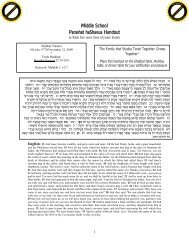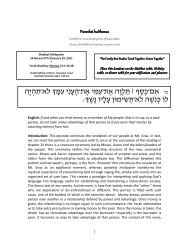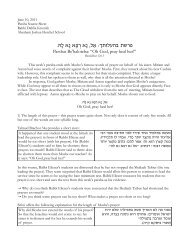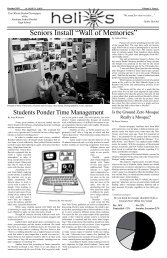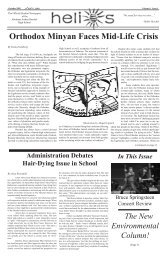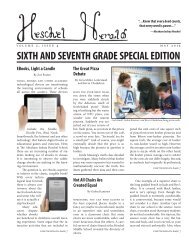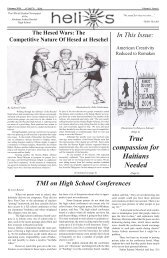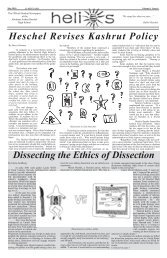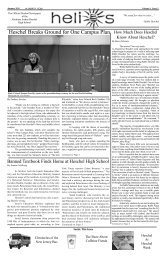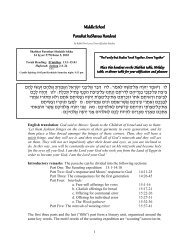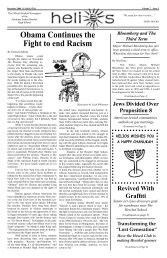Volume 1, Issue 5 (June 2011) - The Heschel School
Volume 1, Issue 5 (June 2011) - The Heschel School
Volume 1, Issue 5 (June 2011) - The Heschel School
Create successful ePaper yourself
Turn your PDF publications into a flip-book with our unique Google optimized e-Paper software.
“…Know that every deed counts,<br />
that every word is power…”<br />
—Abraham Joshua <strong>Heschel</strong><br />
V o l u m e 1 , I s s u e 5 J u n e 2 0 1 1<br />
<strong>Heschel</strong> Eighth Grader Takes<br />
Home the Gold<br />
By Coby Goldberg<br />
<strong>The</strong> G-Word<br />
By Dylan Posner<br />
It happens every year to the eighth<br />
grade. After they have bonded through<br />
Early Childhood, Lower <strong>School</strong>, Middle<br />
<strong>School</strong>, and through their Israel trip,<br />
they must say goodbye to this part of<br />
their lives. This year, it has happening<br />
to an 8th grade that has become a thoroughly<br />
bonded group. Did it happen<br />
during the two grade-wide snow day gettogethers,<br />
or during the movies we saw<br />
together? Whatever the reason, this tight<br />
group feels that their connection was<br />
torn apart by the g-word, graduation.<br />
About half of the current eighth<br />
grade is not returning to <strong>Heschel</strong> High.<br />
After the end of the year, the unified<br />
grade will go its separate ways. Most fear<br />
that high school will get in the way, and<br />
students will lose connections to one another.<br />
Luckily, the eighth grade has remarkable<br />
memories of its time together.<br />
<strong>The</strong> Graduation Ceremony took<br />
place on <strong>June</strong> 14. Jordan Ofek said, a bit<br />
teary eyed, “Graduation makes me feel<br />
that I’m done here, at <strong>Heschel</strong>, and I’m<br />
taking the next step in life.” Jordan is<br />
using the theme of commencement, as<br />
a beginning and a start of something<br />
new. Numerous eighth graders have remarked<br />
that the Middle <strong>School</strong> has been<br />
one of their favorite places, and it is quite<br />
upsetting and depressing to leave it. One<br />
student, Orly Silverstein, put it this way,<br />
“I’m excited about graduating, but there<br />
is a part of me that wishes we could all<br />
just stay at the Middle <strong>School</strong>.”<br />
After classes for the eighth grade<br />
concluded, on <strong>June</strong> 6, students dove<br />
into an intense week rehearsing for the<br />
ceremony. Anna Savant wrote the script,<br />
using three questionnaires based on the<br />
Middle <strong>School</strong> “experience”: education,<br />
friendships, and the Israel trip.<br />
Anna Savant, director, Joe Ancowitz,<br />
the music director, and Lori Skopp,<br />
the Middle <strong>School</strong> principal, designed a<br />
ceremony that they hope will be remembered<br />
for many years by parents, family,<br />
and friends.<br />
It is certain that all the eighth graders<br />
cherished their graduation, as they<br />
go their separate directions for High<br />
<strong>School</strong>, and will never forget the friends<br />
they’ve made, and memories they have<br />
of <strong>Heschel</strong>. ◆<br />
On Monday, May 23, eighth grader<br />
Jonathan Granowitz won First Place in<br />
the Gotham Games long jump competition.<br />
His winning jump measured 5.2<br />
meters or 17 feet. <strong>The</strong> Gotham Games<br />
are a competition for the City’s best<br />
private school track and field athletes.<br />
To compete in the Gotham games, the<br />
athlete must place in the top sixteen in<br />
a qualifying event. Despite a stellar performance<br />
in the games themselves, the<br />
qualifying process was not made easy for<br />
Granowitz; he had to go to the qualifying<br />
meet only a few hours after his arrival<br />
back in New York from Israel. After<br />
almost jumping five meters in the qualifiers<br />
(he jumped 4.94 meters), Granowitz<br />
said he, “set a goal of jumping five meters.<br />
It felt fulfilling to reach that goal.”<br />
Once all the competitors had<br />
jumped three times, Granowitz was<br />
pronounced the official winner. An announcement<br />
was then made on the Middle<br />
<strong>School</strong> loudspeaker that he had won.<br />
Rick Munn had this to say, “Jumping<br />
17 feet is pretty impressive. When I was<br />
doing long jump with fifth graders in<br />
school I set out three mats… I told them<br />
Continued on page 3
2010-<strong>2011</strong><br />
Editors<br />
Coby Goldberg<br />
Daniel Ernst<br />
Daniella Nevid<br />
Sydney Shaiman<br />
Contributing Writers<br />
Alexa Ringer<br />
Aliza Astrow<br />
Amelia Sylvor-Greenberg<br />
Ariella Kahan<br />
Benjamin Shapiro<br />
Benjamin Sternklar-Davis<br />
Chloe Weinstein<br />
Dylan Posner<br />
Eliana Salmon<br />
Ella Kaplun<br />
Hallie Fawer<br />
Hannah Zhukovsky<br />
Jonathan Mack<br />
Laura Glesby<br />
Mirina Rosen<br />
Nico Miller<br />
Noah Shapiro<br />
Ronen Schatsky<br />
Sasha Chanko<br />
Sonia Epstein<br />
Artists<br />
Lizzy Kaner<br />
Orly Silverstein<br />
Photographers<br />
Karen Dorr<br />
Daniel Ernst<br />
Judy Katz<br />
Rick Munn<br />
Faculty Advisor<br />
Karen Dorr<br />
Layout & Design<br />
Abe Hendin<br />
Letter from the Editors<br />
Dear <strong>Heschel</strong> Middle <strong>School</strong>,<br />
It’s hard to believe that a whole<br />
school year has gone by since the beginning<br />
of the <strong>Heschel</strong> Herald. At the beginning<br />
of this year, the <strong>Heschel</strong> Herald was<br />
just a distant idea in the minds of some<br />
hopeful eighth graders. It seems like<br />
just yesterday that we were dreaming up<br />
names and mastheads for our new newspaper.<br />
Now, ten months later, thanks to<br />
you, the <strong>Heschel</strong> Herald has become a<br />
reality.<br />
<strong>The</strong> issues produced this year have<br />
been a breakthrough in our school’s<br />
news distribution. We are very proud of<br />
what this newspaper has become, and<br />
we are positive that you have enjoyed<br />
it. Thank you for the support you have<br />
shown.<br />
As we, the eighth graders, leave<br />
the Middle <strong>School</strong> and continue on to<br />
high school, we have only one wish for<br />
the future of this newspaper. We wish<br />
that the <strong>Heschel</strong> Herald will continue<br />
to flourish and grow under the leadership<br />
of its new editors, Amelia Sylvor-<br />
Greenberg, Ariella Kahan, and Nico<br />
Miller. We truly believe that the <strong>Heschel</strong><br />
Herald has a bright future.<br />
It has been a pleasure for all of us<br />
to be the editors of this great newspaper<br />
this year. We wish you a fantastic summer<br />
full of fun, friends, and laughter,<br />
and good luck in the coming school year.<br />
Sincerely,<br />
Daniel Ernst<br />
Coby Goldberg<br />
Daniella Nevid<br />
Sydney Shaiman<br />
<strong>Heschel</strong> Herald Editors<br />
Letter to the Editors<br />
Dear Editors,<br />
I want to publicly thank you for<br />
your dedication and extraordinary efforts<br />
to create a new and improved<br />
school newspaper, the <strong>Heschel</strong> Herald.<br />
As you may recall, the staff in the fall began<br />
with twelve reporters, and grew to<br />
thirty by mid-year. This growth can be<br />
directly attributed to the enthusiastic response<br />
your first issue garnered, and to<br />
the energy and excitement you brought<br />
to every Tuesday afternoon session.<br />
Each of you contributed your editorial<br />
skills to every article written, and<br />
wrote at least two to three articles for<br />
each issue. You galvanized and led your<br />
staff by example; every week students<br />
diligently worked on their articles motivated<br />
by the desire to deliver interesting<br />
and relevant pieces. You have set a<br />
high bar for the incoming editors, who<br />
I know have been inspired by the model<br />
you set.<br />
I vividly recall the day, last year,<br />
when Daniel Ernst and Coby Goldberg<br />
first approached me. We were walking<br />
to various childcare centers for Hesed.<br />
Daniel and Coby politely introduced<br />
themselves, and declared, “We want<br />
to start another newspaper that students<br />
will actually read!” And the rest is<br />
<strong>Heschel</strong> history…<br />
I will miss you all, and promise that<br />
we will send you next year’s first issue.<br />
Keep journalism alive!<br />
Best wishes,<br />
Karen Dorr<br />
<strong>Heschel</strong> Herald Faculty Advisor<br />
THANK YOU ABE,<br />
FOR ALL YOU DO!<br />
Daniel, Daniella, Coby, Sydney,<br />
& Karen<br />
2 ◆ <strong>Heschel</strong> Herald, <strong>Volume</strong> 1, <strong>Issue</strong> 5 <strong>The</strong> Abraham Joshua <strong>Heschel</strong> <strong>School</strong>
Winding Down? Another<br />
Urban Myth<br />
By Daniel Ernst<br />
It is a commonly held perception that<br />
school ends for the eighth grade after<br />
Spring Break—but not one that is necessarily<br />
true. This year, the eighth grade<br />
has received a surprising amount of<br />
post-Israel schoolwork.<br />
One student has said that the<br />
amount of work in May has been “so<br />
much, more than before Israel. I thought<br />
we were going to come back from Israel<br />
and would be done with school.” This is<br />
certainly not the case.<br />
With class officially ending for the<br />
eighth grade on <strong>June</strong> 6, teachers are<br />
forced to pack in the rest of the year’s assignments<br />
in just three weeks following<br />
Israel. One question is whether or not<br />
teachers “have something to prove.” It<br />
is important to many teachers to make<br />
sure the students know that school certainly<br />
does not end after Passover.<br />
But for many students it is hard to<br />
balance the heavy workload with the<br />
lasting fatigue and jetlag. Having arrived<br />
from Israel on a Monday, followed<br />
by school early Tuesday morning, at<br />
10AM, naturally students were tired Tuesday<br />
night. And “unnaturally,” at least to<br />
us, there was homework to do, during<br />
which a number of students fell asleep.<br />
<strong>The</strong>re is a constant debate about<br />
the right amount of work to give students<br />
immediately after Israel. Of course,<br />
teachers have the right to give work, but<br />
how much is too much? ◆<br />
Journalist of the Month:<br />
Tom Verducci<br />
By Daniel Ernst<br />
For those of you who normally could<br />
care less about international journalism,<br />
here is our first <strong>Heschel</strong> Herald Sports<br />
journalist of the month: Tom Verducci.<br />
Verducci came to the Sports Illustrated<br />
magazine in 1993, following ten<br />
years as a sports journalist for Newsday.<br />
At Sports Illustrated, he is a senior writer<br />
who specializes in professional baseball.<br />
According to Tom Verducci, his<br />
most compelling story was the story<br />
Going Green, One Tissue at a<br />
Time<br />
By Alexa Ringer<br />
If you look around the school, you<br />
may notice something. Not that Jacob<br />
has a new office, or that whiteboard<br />
markers are continuously disappearing<br />
mysteriously. You might observe that<br />
there are green tissue boxes placed in<br />
almost every classroom throughout the<br />
building. Starting at the beginning of<br />
the year, Bev Shnaps began to purchase<br />
these tissue boxes from an office supplier<br />
called Weeks Lerman. <strong>The</strong>se tissue boxes<br />
are “tree-free,” as it says on the small<br />
Sayonara<br />
fo’ the<br />
Summah!<br />
he wrote in 1995<br />
titled “<strong>The</strong> Dead<br />
End Kids.” This<br />
article was about<br />
the struggles of<br />
Darryl Strawberry<br />
and Dwight<br />
Gooden, two<br />
of the New York Mets stars at the time.<br />
He wrote this article soon after joining<br />
Sports Illustrated, when he was assigned<br />
to cover the Mets.<br />
For all of these reasons and more,<br />
Tom Verducci is this year’s last <strong>Heschel</strong><br />
Herald journalist of the month! ◆<br />
green label on each box. “Emerald brand<br />
facial tissue is made from bagasse and is<br />
100% biodegradable,” it says on the back<br />
of the tissue box. It also clarifies why<br />
the material bagasse is used. Sugar cane<br />
is a readily renewable resource, grown<br />
extensively in a number of developing<br />
countries. After the sugar cane is juiced,<br />
the use of the fiber waste provides a value-added<br />
product from what is generally<br />
considered a waste product. When<br />
sugar fiber can be turned into products<br />
normally made from wood pulp, an additional<br />
benefit is the elimination of the<br />
pollution created from wood pulp.<br />
However, the box, containing the<br />
tissues is made from paper. ◆<br />
<strong>Heschel</strong> Softball Wins<br />
Championship<br />
By Coby Goldberg<br />
On Monday, <strong>June</strong> 6, the <strong>Heschel</strong> Softball<br />
team won the championship of its league,<br />
AIPSL, beating Winston Prep six to five.<br />
It was a close and highly competitive<br />
game all the way through. <strong>Heschel</strong> took<br />
the lead in the top of the seventh inning<br />
(the final inning in the AIPSL league) after<br />
Sasha Chanko tripled, Daniel Ernst<br />
drove him in and Sam Lippman drove<br />
Ernst in, making the score six to four.<br />
Lippman pitched the full game and in<br />
the bottom of the seventh allowed the<br />
bases to be loaded. He allowed one run<br />
to score and with two outs and the bases<br />
loaded, induced a ground out to third<br />
base. Said Lippman, “It was exhilarating<br />
and frightening…like nothing I ever felt.<br />
But I knew I could trust my teammates<br />
to make the play in the field.” This win<br />
was especially big after <strong>Heschel</strong>’s one<br />
loss of the season coming at the hands<br />
of Winston prep only a few days before.<br />
One outfielder, Rachel Wenger, said, “It<br />
feels amazing to have come so far after<br />
our first big loss to Winston Prep (a 10<br />
to 0 defeat). It was a lot of fun and a very<br />
exciting game.” Congratulations to the<br />
whole Softball team! ◆<br />
GOLD, cont’d from page 1<br />
that one kid in the Middle <strong>School</strong> would<br />
have needed a fourth mat, and they were<br />
in awe.”<br />
Congratulations to Jonathan on taking<br />
home the gold! ◆<br />
<strong>The</strong> Joseph Slifka Middle <strong>School</strong> <strong>June</strong> <strong>2011</strong> ◆ 3
Eighth Grade in Israel<br />
“In Israel, in order to be a realist you must believe in miracles.” —David Ben Gurion, 1956<br />
Yom Haatzmaut in Israel<br />
By Daniella Nevid<br />
This year the eighth grade had<br />
the privilege of celebrating Yom<br />
Haatzmaut, Israel’s Independence Day,<br />
in Israel, a truly special experience. Yom<br />
Haatzmaut has so much meaning and<br />
value to the people living in Israel; it<br />
means one more year that this world finally<br />
recognizes Israel as a Jewish state.<br />
<strong>The</strong> day preceding Yom Haatzmaut<br />
is Yom Hazikaron, the Israeli Memorial<br />
Day where all of Israel mourns the fallen<br />
soldiers. <strong>The</strong> effect of having one day of<br />
sorrow preceding another day of complete<br />
joy and celebrations is quite strong.<br />
<strong>The</strong> entire country goes from utter stillness<br />
to all around thrill and pleasure.<br />
Still there is a connection between both<br />
days that is very beautiful; everyone in<br />
the country cries for one another as if<br />
they were each other’s brothers, sisters,<br />
parents or children, and then the next<br />
day they all celebrate together as one<br />
family. <strong>The</strong>re is no other nation that I<br />
can think of that has such pride in their<br />
Yom Hazikaron Ceremony in<br />
Be’er Sheva<br />
By Daniel Ernst<br />
In Israel, the majority of the population<br />
is bound by a unifying culture, and<br />
a unifying sense of patriotism. Although<br />
I am not Israeli, never before have I felt<br />
so much a part of this nationalism than<br />
at the ceremony commemorating Yom<br />
HaZikaron (Remembrance Day) in the<br />
city of Be’er Sheva.<br />
It was a cold night when we got off<br />
the bus in Be’er Sheva. We walked to a<br />
large square filled with seats, and a platform<br />
in front of the chairs. After everyone<br />
settled in, the Master of Ceremonies<br />
spoke briefly, and then the siren sounded.<br />
It was a shockingly loud, wailing siren.<br />
It was an air raid siren; its pitch went<br />
eyes on their independence day as Israel<br />
does.<br />
On Erev Yom Haatzmaut, the eve of<br />
Yom Haatzmaut, the country makes the<br />
transition between Yom Hazikaron and<br />
Yom Haatzmaut and that is when the festivities<br />
begin. Every city, town, kibbutz<br />
and home has some sort of celebration<br />
ranging from bonfires to concerts and<br />
festive dinners.<br />
As a part of our Israel trip the eighth<br />
grade had an opportunity to attend the<br />
city of Be’er Sheva’s Yom Haatzmaut<br />
concert. We arrived at the town plaza at<br />
Continued on page 10<br />
up then down and back up; it sounded<br />
like someone was crying. It gave me<br />
goose bumps, and made the hair on my<br />
arms stand straight up. Its sound demanded<br />
that I think; I thought about<br />
how everyone in the State of Israel was<br />
standing at this moment, hearing the<br />
same siren I was hearing, and thinking<br />
similar thoughts. Israel is a unified<br />
country, unified through the young men<br />
and woman it has lost in the name of<br />
freedom.<br />
After a long, long minute, Israelis<br />
sat down, and the ceremony continued.<br />
It continued with tearful speeches and<br />
heart-wrenching songs. It didn’t matter<br />
that I couldn’t fully understand the complex<br />
language they were using; I knew<br />
what they were saying.<br />
And then came a family—a mother,<br />
a father, and a brother, mourning the<br />
Jerusalem: A Synagogue for<br />
Everyone<br />
By Aliza Astrow<br />
On the eighth grade Israel trip, the<br />
eighth grade had the opportunity to attend<br />
Shabbat services at different synagogues<br />
in Jerusalem. Each student chose<br />
from among several options where they<br />
wished to attend services. Each of the<br />
synagogues offered an out of the ordinary<br />
experience, and everyone enjoyed<br />
the chance to participate in Israeli services<br />
different from the ones we are used<br />
to in New York. <strong>The</strong> following are the divergent<br />
synagogues that students in the<br />
eighth grade attended.<br />
Shira Hadasha is a liberal modern<br />
Orthodox service, with a translucent<br />
mechitza. Women are allowed to lead<br />
the services and read from the Torah.<br />
<strong>The</strong>re was a lot of singing, contrary to<br />
many traditional Orthodox services.<br />
Kol Haneshama is a Reconstructionist<br />
synagogue with a focus on<br />
Continued on page 10<br />
loss of their young son Yonatan. <strong>The</strong><br />
simplicity of their speech meant I could<br />
understand every word of the lamenting<br />
story of a mother answering a knock on<br />
the door one Erev Shabbat. During that<br />
story it didn’t matter that it was freezing<br />
outside, or how tired I was. I felt like<br />
I was mourning each of Israel’s losses,<br />
that I was mourning my own people. ◆<br />
4 ◆ <strong>Heschel</strong> Herald, <strong>Volume</strong> 1, <strong>Issue</strong> 5 <strong>The</strong> Abraham Joshua <strong>Heschel</strong> <strong>School</strong>
Masada<br />
By Coby Goldberg<br />
On the recent eighth grade class trip<br />
to Israel, one of the many places visited<br />
was Masada. Masada is a mountain overlooking<br />
the Dead Sea which King Herod<br />
built into a fortress as a place of refuge<br />
for himself in case of a revolt. During<br />
the First Roman-Jewish War, a group<br />
of Jews led by Eliezer Ben-Yair used the<br />
mountain fortress as a base for harassing<br />
Romans. <strong>The</strong> Romans then laid siege<br />
to Masada and after three months were<br />
finally prepared to breach the fortress<br />
and take the mountain. However, upon<br />
reaching the top of the mountain the<br />
Romans found that all of the inhabitants<br />
had committed mass suicide.<br />
After waking up at four in the morning<br />
and hiking to the top of the mountain<br />
in time to watch the sunrise, the<br />
eighth grade went to an overlook. At the<br />
overlook, when you shouted, there was a<br />
loud echo a few seconds later that sounded<br />
like many voices. At this point our<br />
tour guide had us shout the phrase that<br />
graduates of basic training in the army<br />
say as a sort of allegiance while atop Masada,<br />
“Masada lo tipol shenit”, “Masada<br />
will not fall again.”<br />
At this point I realized what Masada<br />
represented and why it is such an<br />
important place. Masada represents the<br />
beginning of the two thousand years of<br />
exile. It was the last place of Jewish resistance<br />
for two thousand years. <strong>The</strong> falling<br />
of Masada would represent the downfall<br />
of the Jewish state of Israel, a second<br />
exile, which is why Masada cannot fall<br />
again. ◆<br />
Eighth Grade in Israel<br />
An Israeli Energy Dilemma<br />
By Ben Sternklar-Davis<br />
Israel’s lack of domestic natural<br />
resources such as oil and gas has been<br />
acknowledged for many years. David<br />
Ben Gurion foresaw the future when he<br />
set a personal example by choosing to<br />
settle in Kibbutz Sde Boker at the centre<br />
of the Negev, and established the National<br />
Water Carrier to bring water to<br />
the area. He saw the struggle to make the<br />
desert bloom as an area where the Jewish<br />
people could make a major contribution<br />
to humanity as a whole. From Israel’s beginning,<br />
the need for energy resources<br />
has meant that Israel has had to invest in<br />
greener, more efficient energy technology<br />
such as solar power and wind farms.<br />
Yet the recent discovery of huge reserves<br />
of natural gas off the country’s northern<br />
coast threatens the country’s adoption of<br />
greener energy.<br />
Israel uses its energy very resourcefully.<br />
It has almost constant sunlight<br />
and therefore it is capable of generating<br />
a great amount of electricity due to the<br />
hundreds of solar fields. Additionally,<br />
Israel has many hilltop wind turbines,<br />
Politics and the Israel Trip<br />
By Ronen Schatsky<br />
During a two-week-long experience<br />
in Israel, eighth graders had numerous<br />
opportunities to develop their opinions<br />
and feelings about Israeli politics. To<br />
determine whether this happened, this<br />
reporter briefly asked a representative<br />
sample of eighth graders whether the<br />
trip affected their views about Israeli<br />
politics; approximately one quarter of<br />
this sample answered in the affirmative.<br />
One of them, Sarah Joyce, states<br />
that she “used to think of Israel as just<br />
another country,” but now she feels it is<br />
“her home.” This has caused her to, “take<br />
a stronger stand in its politics.” It is clear<br />
that Sarah’s intimate experiences, with<br />
the land and its people, impacted her political<br />
interests. Apparently, the trip was<br />
somewhat successful in connecting students’<br />
interest in Israeli politics. <strong>The</strong> assertions<br />
of other eighth graders, support<br />
which generate much wind electricity. It<br />
also has many water turbines.<br />
In 2009, about 120 trillion cubic<br />
feet of gas reserves were discovered in<br />
the Mediterranean, much of it within<br />
Israeli territory. Some months later, another<br />
field, sized at 8.7 trillion cubic feet,<br />
was found, and then a second, twice the<br />
size. <strong>The</strong>se gas fields are so big that Israel<br />
could easily become an exporter of nonrenewable<br />
energy.<br />
Now some Israelis are concerned<br />
that the use of nonrenewable energy will<br />
force the renewable energy plants to shut<br />
down. On the other hand, if Israel can<br />
replace its coal-based electricity with gas,<br />
this might mean that the air will become<br />
cleaner and new technology such as gaspowered<br />
public transport and electric<br />
cars will develop.<br />
<strong>The</strong> discovery of such huge gas reserves<br />
could make a big difference to<br />
Israel’s economy. Many hold the hope<br />
that it will not affect the development of<br />
renewable energy, and will not mean a<br />
complete return to a wasteful and environmentally<br />
destructive time, especially<br />
since Israel currently has the greenest<br />
energy policies in the region. ◆<br />
this. Lena Diamond, for example, describes<br />
greater awareness of the goingson<br />
of the State after the trip. Moreover,<br />
Dassi Kalmanofsky says that her preexisting<br />
opinions about Israel “became<br />
stronger,” mainly because of “the argument<br />
on the bus.”<br />
Dassi’s remarks highlight another<br />
aspect of the trip: the conversations<br />
among students, who seemed to become<br />
closer as the trip wore on. <strong>The</strong> said “argument,”<br />
really more a shouting match<br />
of opposing views than a disciplined<br />
expression of opinions, exemplifies a<br />
social situation that further developed<br />
students’ opinions about Israel. As often<br />
happens when students have strong<br />
feelings, few opinions could be fully<br />
expressed without interruptions from<br />
those with opposing viewpoints. So, it<br />
was not clear how much was learned<br />
from the perspectives of others, but, at<br />
Continued on page 10<br />
<strong>The</strong> Joseph Slifka Middle <strong>School</strong> <strong>June</strong> <strong>2011</strong> ◆ 5
Washington, DC and Philadelphia<br />
DC Trip—National Gallery<br />
By Ariella Kahan<br />
On the last day of the Washington<br />
D.C. trip, the seventh graders went to the<br />
National Gallery. <strong>The</strong> National Gallery<br />
is an extraordinary art museum with<br />
an exceptional collection of art from the<br />
Renaissance. <strong>The</strong> seventh grade focused<br />
on Renaissance art during their tours of<br />
the museum to augment their humanities<br />
study of the Renaissance.<br />
In the National Gallery, the grade<br />
was split into four groups based on their<br />
advisory. For an hour, each group was<br />
led by a tour guide through the museum<br />
and learned about<br />
a variety of paintings.<br />
<strong>The</strong> paintings<br />
were by Botticelli,<br />
Leonardo da Vinci,<br />
Bellini, Titian<br />
and many other<br />
great artists. Some<br />
paintings that the<br />
seventh grade saw<br />
were: Ginevra de’<br />
Benci, <strong>The</strong> Adoration<br />
of the Magi, both by Leonardo<br />
da Vinci and many others. Many of the<br />
paintings had Christian themes, but one<br />
unique painting depicted a story from<br />
the Torah. This was exciting to many<br />
students because after seeing numerous<br />
paintings of the Madonna and the Saints,<br />
it was exciting to see that the Torah was<br />
also a subject of art during the Renaissance.<br />
Additionally, it was great to connect<br />
what we saw in the museum to our<br />
studies in class. As one seventh grader<br />
said, “It was very exciting to see the<br />
paintings of artists we have been learning<br />
about all year. We saw paintings of<br />
Botticelli, and we read Primavera which<br />
was based on the painting ‘Primavera’ by<br />
Botticelli.”<br />
Two of the four tour guides were<br />
very good, and made the experience at<br />
the National Gallery a favorite of many<br />
students, but unfortunately the other<br />
two tour guides were not as good. Because<br />
of this, the National Gallery got<br />
mixed reviews. Some students called it,<br />
“amazing,” and said it was the best part<br />
of their trip. Other students did not like<br />
it as much, and were disappointed in<br />
the museum. One seventh grader said,<br />
“It was one of the<br />
best museums<br />
of the trip!” Another<br />
said, “it was<br />
very interesting<br />
and we learned<br />
about some of<br />
the Ancient gods<br />
and also about a<br />
famous painter<br />
named Titian.<br />
overall the paintings<br />
were beautiful and articulate.” Although<br />
many reviews of the museum<br />
were very positive, other students were<br />
not as favorable about the National Gallery.<br />
Some students thought they were<br />
too tired to enjoy the museum, and<br />
others thought the tour guide was boring.<br />
Despite the negative reviews, many<br />
students agreed that all around, the<br />
museum was both fun and interesting.<br />
However, many seventh graders hope<br />
the sixth grade will have better luck with<br />
their tour guides next year! ◆<br />
We May Look Different<br />
By Hallie Fawer and Noah Shapiro<br />
On May 4, <strong>2011</strong>, the sixth grade went to<br />
the Amish country in Lancaster, Philadelphia<br />
with Shoshana Jebwab, Marilyn<br />
Tawil, Paulette Cohen, David Frankle,<br />
and Donna Aber. After they saw the<br />
film “Jacob’s Choice,” a brief film that<br />
explained certain Amish traditions, they<br />
explored a model of an Amish one-room<br />
schoolhouse, and then visited an Amish<br />
farmer’s house. Once students were inside<br />
and seated, Sam Riehl, the farmer,<br />
welcomed everyone. He reminded students<br />
that every culture has different<br />
beliefs, and that they may look different<br />
but they, like everyone, “are still just human<br />
beings on earth.”<br />
As a matter of fact, a lot of people<br />
thought that the Amish’s homes would<br />
look different from ours. To most people’s<br />
surprise, there were few differences.<br />
A sixth grader commented, “<strong>The</strong>ir houses<br />
looked exactly like ours, except there<br />
were no electric lights, televisions, or<br />
computers. Though everyone noted that<br />
their clothes were different than ours, no<br />
one really focused on that, but instead,<br />
focused on the fact that their activities<br />
were different. Instead of sitting on a<br />
couch with their eyes glued to their electronics,<br />
they were doing farm work, and<br />
even the younger children helped.”<br />
Amish farmer Sam Riehl also explained<br />
to the sixth graders about the<br />
tradition of “Rumspringa,” which is defined<br />
in German as, “running around.”<br />
This refers to a period that begins at<br />
Continued on page 10<br />
Holocaust Museum Exhibit:<br />
“State Of Deception”<br />
by Nico Miller<br />
<strong>The</strong> seventh grade traveled to<br />
Washington DC on May 5. While there,<br />
they went to an exhibit in the Holocaust<br />
Museum about Nazi propaganda, called<br />
“State of Deception.” When students first<br />
walked into the exhibit, the sound of<br />
Nazi marching music and the sight of<br />
bright colored posters instantly bombarded<br />
them. <strong>The</strong>se posters depicted<br />
a “happy” group of young people who<br />
were going to save the world by getting<br />
rid of the Jews. <strong>The</strong>re was no mention<br />
of the Nazis’ assault on Europe or anything<br />
negative. <strong>The</strong> exhibit’s design was<br />
intended to make the viewer feel happy<br />
and safe.<br />
If the viewer did not know that this<br />
exhibit was about something horrifying<br />
like the Holocaust, he would have<br />
thought that Hitler was doing something<br />
good. It was clear how powerful<br />
propaganda is, and how easy it is to get<br />
manipulated by it. First of all, the joyous<br />
marching music brought a happy<br />
atmosphere to the room. Next, there<br />
were posters depicting people smiling<br />
Continued on page 10<br />
6 ◆ <strong>Heschel</strong> Herald, <strong>Volume</strong> 1, <strong>Issue</strong> 5 <strong>The</strong> Abraham Joshua <strong>Heschel</strong> <strong>School</strong>
Washington, DC and Philadelphia<br />
Beth Sholom Synagogue:<br />
Frank Lloyd Wright or Frank<br />
Lloyd Wrong?<br />
<strong>The</strong> Sixth Grade’s First Taste of Modern<br />
Architecture<br />
By Hannah Zhukovsky<br />
After an early wake-up call, the<br />
sixth graders all piled into the coach<br />
bus, then, after a long and sleepy ride,<br />
managed to stumble out of the bus into<br />
a strange pyramid figure supported by<br />
obelisks at its side; the building is the<br />
Beth Sholom Synagogue designed by<br />
Frank Lloyd Wright, the architect of the<br />
Guggenheim Museum.<br />
After walking through a long carpeted<br />
hallway, we were greeted by Mordechai<br />
and Mati Rosentein, grandparents<br />
of fellow sixth grader Ava Pearlman.<br />
We were then ushered into one of the<br />
many chapels to watch a short video<br />
about the construction of the building.<br />
<strong>The</strong> Rabbi of Beth Sholom Synagogue, at<br />
that time, was Mortimer J. Cohen. When<br />
Rabbi Cohen was at Beth Sholom, many<br />
members of the synagogue, located in<br />
Philadelphia, left to move to the suburbs,<br />
and the old building was in disrepair. He<br />
decided to move the synagogue to Elkins<br />
Park, and to build a new synagogue.<br />
Rabbi Cohen’s mission was to expand<br />
the congregation attending the Synagogue,<br />
and at the same time think about<br />
the architecture of the new building to<br />
connect Judaism with the modern world.<br />
He even said he wanted a building that<br />
had “the American spirit wedded to the<br />
ancient spirit of Israel.”<br />
In order to accomplish his dream,<br />
in 1953 Rabbi Cohen sent Frank Lloyd<br />
Wright , one of the most famous and<br />
accomplished architects in the world, a<br />
personal letter to convince him to consider<br />
the project. Frank Lloyd Wright<br />
at the time was best known for designing<br />
the extraordinary home, “Falling<br />
Water.” Wright, a Welsh Unitarian, had<br />
been asked before to design and build<br />
a synagogue, but had always refused.<br />
Rabbi Cohen would not take “no” for an<br />
answer, and after much coaxing, Wright<br />
agreed to go along with the project.<br />
After meeting, Cohen and Wright<br />
soon became great friends, and Cohen<br />
maintained the position of Co-Designer<br />
of the building, a position never given<br />
away before by Wright. Thus, they started<br />
to work on the six-sided pyramid with<br />
tripod beams laden with plastic panels<br />
within the structure, which resembled<br />
Mount Sinai.<br />
After the video, we walked up the<br />
carpeted stairs into the main sanctuary.<br />
As soon as we arrived into the room,<br />
there were gasps of “oohs”, and “aahs.”<br />
Many kids loved the open space, while<br />
others said it was too “overwhelming.”<br />
<strong>The</strong> main sanctuary, when first looked at,<br />
resembles a modern cubist design done<br />
to give the sacred holy place an “edge.”<br />
However, the inside, such as a piece of<br />
Jewish text, has many deep interpretations<br />
of mystical ideas and tradition.<br />
<strong>The</strong> only difference between the two is<br />
that the interpretations are played out in<br />
the many facets of the architecture, not<br />
words. Inside the main sanctuary, where<br />
the pyramid peaks, the floor is tilted in a<br />
certain way, which gives the effect of one<br />
being cupped in God’s hands. <strong>The</strong> Bima,<br />
a representation of angels ascending to<br />
heaven, is lined with modern shaped<br />
patterns (usually six on each side, to<br />
represent the twelve tribes) and in the<br />
middle is the triangular shaped ark with<br />
Continued on page 12<br />
So You Think You Can Fly?<br />
By Ella N. Kaplun<br />
<strong>The</strong> man who said, “Tell me, have I<br />
done anything of worth?” Is the same<br />
man who invented the Great Kite, the<br />
ornithopter flying machine, the parachute,<br />
and who painted the Mona Lisa.<br />
This Renaissance man was Leonardo Da-<br />
Vinci.<br />
During the sixth grade trip to Pennsylvania,<br />
specifically Lancaster and<br />
Philadelphia, sixth graders went to the<br />
Leonardo DaVinci exhibit in the Franklin<br />
Institute. <strong>The</strong>re, we watched a video<br />
about Leonardo, looked at Leonardo’s<br />
paintings, read his journal entries, and<br />
viewed the astounding drawings of his<br />
inventions. Much of what we saw was<br />
Leonardo’s actual writing, as well as<br />
touch screen reproductions of his work.<br />
Before we went to the museum Gary<br />
asked that we choose one invention of<br />
DaVinci’s that we’d like to take home.<br />
Would we choose: <strong>The</strong> Great Kite, Aerial<br />
Screw, Mechanical Lion and Bat, Self-<br />
Propelled Cart, or the Harpsichord Viola.”<br />
Looking at thirty-seven results,<br />
three people wanted to bring the Aerial<br />
Screw home, twenty people wanted to<br />
bring home the Great Kite, five people<br />
wanted to bring home the Mechanical<br />
Lion and Bat, five people wanted to bring<br />
home a Self-Propelled cart, and four others<br />
opted for the harpsichord-viola.<br />
In 1498, Leonardo DaVinci completed<br />
work on his painting, “<strong>The</strong> Last<br />
Supper.” He thought of flying machines<br />
400 years before electronic flying machines<br />
were made. In addition, he helped<br />
Continued on page 11<br />
<strong>The</strong> Joseph Slifka Middle <strong>School</strong> <strong>June</strong> <strong>2011</strong> ◆ 7
Washington, DC and Philadelphia<br />
Lockup: <strong>The</strong> Eastern State<br />
Penitentiary<br />
By Eliana Salmon<br />
<strong>The</strong> sixth graders’ last stop on their<br />
Pennsylvania trip was the notorious<br />
Eastern State Penitentiary. Located in<br />
Philadelphia, Pennsylvania, the Eastern<br />
State Penitentiary was once a prison<br />
for some of the world’s worst criminals,<br />
including Al Capone. <strong>The</strong> penitentiary<br />
opened in 1829 and housed criminals for<br />
142 years, until it was shut down in 1971.<br />
<strong>The</strong> penitentiary reopened as a tourist<br />
site and is now a U.S. National Historic<br />
Landmark.<br />
It has become one of the most famous<br />
prisons in America; people visit<br />
to see the architecture of the structure.<br />
<strong>The</strong>re are tall walls that surround the<br />
prison that reach up to 30 feet high and<br />
are anchored 10 feet under the ground.<br />
From the outside, the penitentiary gives<br />
the viewer the impression of a Gothic<br />
castle; the tour guide explained the design<br />
was intended to scare off any unwanted<br />
visitors. One thing that truly<br />
surprised the students was that it was<br />
one of the most expensive buildings in<br />
America of its time, and the prisoners<br />
had indoor plumbing before it was installed<br />
in the White House. <strong>The</strong>re was a<br />
very specific reason for this. <strong>The</strong> builders<br />
believed in “reform.”<br />
Before Eastern State Penitentiary,<br />
prisons were very violent places and all<br />
types of criminals were mixed in together.<br />
For example, murderers were put in<br />
the same cell as thieves. <strong>The</strong> founders of<br />
Eastern State Penitentiary believed that<br />
all criminals (even if they had committed<br />
notorious crimes) were created in<br />
the image of god, and they could be reformed.<br />
<strong>The</strong>y believed that other prisons<br />
made prisoners worse than when they<br />
arrived.<br />
When criminals arrived at Eastern<br />
State, they were held in solitary confinement.<br />
<strong>The</strong>y did not leave their cells and<br />
received their food through a slot in the<br />
door. Indoor plumbing meant that criminals<br />
could remain in complete solitude.<br />
<strong>The</strong> founders of the Eastern State Penitentiary<br />
believed that their way would<br />
cause the criminal to regret what they<br />
did, and feel shameful.<br />
Each cell was twice the size of cells<br />
at other prisons. <strong>The</strong> cells consisted of a<br />
cot, a toilet, and a small table. Each cell<br />
had its own small yard where the prisoners<br />
would exercise for one hour each day,<br />
but in solitary confinement. Every cell<br />
had a skylight that the prisoners called<br />
the dead eye or God’s eye. <strong>The</strong> walls<br />
were very thick so that the criminals<br />
heard no noise and there was absolute<br />
silence all the time. When the prisoners<br />
first arrived, they were led to their cells<br />
with their eyes covered. <strong>The</strong> blindfolds<br />
prevented the prisoners from seeing the<br />
layout of the prison; nor could they see<br />
any of other prisoners and their cells.<br />
As soon as they entered the prison, they<br />
were no longer addressed by their name,<br />
but they only had a number. As a reward<br />
for being good prisoners, the criminals<br />
would receive a book to read, the Holy<br />
Bible. <strong>The</strong> prisoners were allowed only<br />
two to three showers a month although<br />
there were unsanitary conditions. Mice,<br />
rats, and insects were common in the<br />
prison. At the turn of the century, conditions<br />
got even worse.<br />
At that time the prison population<br />
increased and they could no longer keep<br />
the prisoners in solitary confinement.<br />
Inmates started sharing cells and there<br />
were 4 to 5 prisoners in one cell. <strong>The</strong><br />
number of criminals arriving at Eastern<br />
State kept increasing, and the prison had<br />
to build a second floor. <strong>The</strong> prisoners<br />
no longer had an exercise yard, and the<br />
criminals on the first floor had no skylight.<br />
<strong>The</strong>y built a field for the inmates to<br />
exercise together outdoors.<br />
Over the period of time in which<br />
Eastern State was an active prison, there<br />
were only 100 escapes and only one escaped<br />
without getting caught. His story<br />
is the most famous escape story at the<br />
penitentiary. Six men gathered together<br />
to plan their escape. One of the men<br />
was a carpenter and he built a ladder. In<br />
broad daylight, the 6 men climbed over<br />
the wall using the ladder and once out<br />
of the prison, they hijacked a few cars.<br />
Five of the men were caught and brought<br />
back to the penitentiary, but one was<br />
never found.<br />
One thing that many of the sixth<br />
graders found surprising was the fact<br />
that the prison had a synagogue. About<br />
80 inmates were Jewish and went to the<br />
synagogue to pray. <strong>The</strong>y had a kosher<br />
kitchen and an ark that held a Torah.<br />
Interesting Facts<br />
• Al Capone had his tonsils removed<br />
at the prison infirmary.<br />
• Babe Ruth came to play baseball<br />
with the inmates.<br />
• <strong>The</strong>y had a greenhouse where they<br />
would grow vegetables for the prisoners.<br />
• <strong>The</strong>re were many cats roaming the<br />
prison when it first opened.<br />
• In the mid-twenties, there were<br />
more than 1800 inmates at Eastern<br />
State. ◆<br />
8 ◆ <strong>Heschel</strong> Herald, <strong>Volume</strong> 1, <strong>Issue</strong> 5 <strong>The</strong> Abraham Joshua <strong>Heschel</strong> <strong>School</strong>
After Two Long Years,<br />
Vending Machine Finally Shut<br />
Down—For Good<br />
By Daniel Ernst<br />
<strong>The</strong> decision to permanently shut<br />
down the vending machine was made<br />
earlier this semester by principal Lori<br />
Skopp, and Beverly Shnaps-Morris. After<br />
going through numerous vendors, while<br />
facing constant problems, it was decided<br />
that having this vending machine was<br />
simply not worth the countless hours<br />
spent managing its flaws.<br />
<strong>The</strong> vending machine, sometimes<br />
considered Student Council’s greatest<br />
A Sarcastic Ode To the<br />
Vending Machine<br />
By Amelia Sylvor-Greenberg<br />
I have sad news to report; the vending<br />
machine died. It’s gone. Everyone really<br />
loved that thing, and I’ve got to admit<br />
that it was pretty swanky. I mean, you<br />
could put $1.50 in, and that magic food<br />
robot would give you a bag of “organic”<br />
potato chips or a “healthy” soda. So like I<br />
said, swank-o-rama. I didn’t have much<br />
against the vending machine, only one<br />
or two issues with it. Or three or four…<br />
<strong>Issue</strong> #1: <strong>The</strong> fact that people would<br />
always hang out in front of the vending<br />
machine. People are like moths, and<br />
for some reason they’d just flock to the<br />
machine. <strong>The</strong>y would stand there without<br />
buying anything. <strong>The</strong>y would press<br />
their faces against the glass and stare at<br />
the food for an entire 10-minute break.<br />
Come on, people. Were the snacks in<br />
there REALLY that exciting?<br />
<strong>Issue</strong> #2: <strong>The</strong> healthy snacks that<br />
weren’t really that healthy at all. Think<br />
about it: just because the soda was<br />
mango flavored didn’t mean it was better<br />
for you than Sprite. Just because the<br />
cookies said “natural” on the packaging<br />
didn’t mean that they were not cookies.<br />
Naturally blue potato chips are still just<br />
starch fried in oil. But the vending machine<br />
brainwashed everyone with the big<br />
slogans written on it: “Health! Environmentalism!<br />
Organic!”<br />
<strong>Issue</strong> #3: How people complained<br />
when the machine was closed because<br />
there were some peanuts in it. It’s pretty<br />
inconsiderate. So many people in this<br />
school have nut allergies, and it isn’t cool<br />
that people want to risk other kids’ lives<br />
so they can have a snack. It makes me<br />
want to ask them, “Hey, you want that<br />
granola bar so very much that you will<br />
risk making someone have an allergy attack<br />
in order to eat it?”<br />
<strong>Issue</strong> #4: this one is the most obvious.<br />
<strong>The</strong> machine was just a money<br />
waster. I mean, I think we all have access<br />
to snacks at home, so why should we pay<br />
extra to eat snacks that have been regurgitated<br />
by the school’s residential robot?<br />
And worse, not only did the robot eat<br />
money, but also it never spat up change.<br />
You could give the robot your $5 bill for<br />
your $1 snack, but the robot might decide<br />
to be greedy and take all your money.<br />
Silly robot.<br />
So there you have it: my four complaints<br />
about the vending machine. Despite<br />
those four tiny issues, the vending<br />
machine will be missed. Rest in peace,<br />
oh great snack robot. Rest in Peace.<br />
(You can e-mail me your angry<br />
rants against this article at ameliasy@<br />
heschel.org.) ◆<br />
accomplishment, was brought to the<br />
Middle <strong>School</strong> by the 2008-2009 Middle<br />
<strong>School</strong> Student Council members. It was<br />
received extremely well by students, and<br />
was frequently used- while it was working.<br />
But what came with the vending<br />
machine was a series of never-ending<br />
problems and elusive vendors. Most recently<br />
the vending machine had to be<br />
temporarily unplugged due to nut products<br />
being found in the vending machine.<br />
Unfortunately the vendor was on<br />
a three-month long vacation, and could<br />
not fix the situation. When the vendor<br />
finally returned, the nut item was replaced,<br />
however this time, with a nonkosher<br />
item. And this was not the first<br />
unsuccessful vendor that the school has<br />
used.<br />
Finally, the decision was made to<br />
discontinue its use, and just chuck the<br />
thing. <strong>The</strong> vending machine does not<br />
cost money to house and the money<br />
from sales go directly to the vendor.<br />
However the hassle of dealing with unreliable<br />
vendors pushed the school’s decision.<br />
<strong>The</strong> current Student Council has<br />
been dealing with possible alternatives<br />
for the vending machine, although it is<br />
unlikely that they will come up with any<br />
significant replacement. ◆<br />
Soaring Words<br />
By Ariella Kahan<br />
On Thursday, May 12, the Hesed Club<br />
decorated a blanket that will be delivered<br />
to a sick child in the hospital. This<br />
event was run by the Soaring Words<br />
foundation. <strong>The</strong> head of Soaring Words,<br />
Lisa, and two <strong>Heschel</strong> High school interns<br />
came during clubs to the Hesed<br />
Club. Lisa explained that she started this<br />
organization to brighten the time that<br />
sick children spent while in the hospital.<br />
<strong>The</strong> idea was to create blankets made by<br />
children of the same age as the recipients.<br />
Every member of the Hesed Club<br />
had an opportunity to decorate at least<br />
one square of a quilt. Everyone was told<br />
not to write anything on the blanket that<br />
might remind the sick child of their illness<br />
like, “get well,” or “feel better soon.”<br />
Instead, everyone drew pictures of rainbows,<br />
flowers, hearts, and covered every<br />
inch of the quilt with happy images.<br />
This activity gave the Hesed club<br />
the opportunity to do something that<br />
did not involve money or fundraising,<br />
but will improve a sick child’s day with<br />
their hands-on effort. Although at first,<br />
many Hesed Club members were not<br />
very excited about doing an activity with<br />
Soaring Words, many people grew to appreciate<br />
the organization, and enjoyed<br />
decorating the blanket. Several Hesed<br />
Continued on page 11<br />
<strong>The</strong> Joseph Slifka Middle <strong>School</strong> <strong>June</strong> <strong>2011</strong> ◆ 9
atzmaut, cont’d from page 4<br />
about 9:30PM and the place was packed.<br />
At about 10:00PM there were fireworks<br />
and then we departed at 10:30.<br />
<strong>The</strong>re were many protestations from<br />
the students when it was time to leave .<br />
Many of the students, including myself,<br />
believed that we should celebrate<br />
for a little bit longer, because it wasn’t<br />
every day that you get to celebrate Yom<br />
Haatzmaut in Israel. Some were annoyed<br />
because people of our age were only just<br />
arriving as we were leaving; it appeared<br />
to us that we were leaving along with the<br />
strollers and grandparents. <strong>The</strong> majority<br />
of the grade was very disappointed with<br />
how the night panned out; everyone had<br />
heard from former eighth graders that<br />
Yom Haatzmaut was the best night of the<br />
trip, and that they always stayed out late<br />
having fun. We were angry and wanted<br />
to stay; we even tried to convince the<br />
teachers to let us, but there were six kids<br />
who were sick, and it wouldn’t have been<br />
good for their health to stay out any later.<br />
That night, I was one of the six sick<br />
ones, and even I wanted to stay out longer<br />
to celebrate. Looking back, I think<br />
that no matter how long we stayed, orwhere<br />
we went it would not have made<br />
for a greater time. We had a great night,<br />
because we were there as a grade- smiling,<br />
laughing and just having fun. At the<br />
time I was pretty upset, but now I regret<br />
that I got so upset, because it soured the<br />
moments that we did get to celebrate. In<br />
truth, until we were informed that we<br />
had to leave, I had a great night celebrating<br />
with Israel, and that’s what I believe<br />
made that night so special. In addition<br />
to enjoying it with my friends, I was feeling<br />
such joy for Israel, and recognizing<br />
a strong connection with Israel that I<br />
hadn’t felt before. ◆<br />
Synagogues, cont’d from page 4<br />
singing and harmonizing. <strong>The</strong> service<br />
is completely egalitarian; both men and<br />
women led the service.<br />
<strong>The</strong> Conegliano Synagogue is a<br />
small Italian shul, which many students<br />
went to for a new experience. Joseph<br />
Harari said, “It was very small and the<br />
ark was very intricate… <strong>The</strong>y even had a<br />
key to open it!”<br />
<strong>The</strong> Great Synagogue is an enormous<br />
modern orthodox shul, in a beautiful<br />
building. <strong>The</strong> women are seated up-<br />
stairs in the huge sanctuary. <strong>The</strong> singing<br />
is grandiose and impressive.<br />
Hovevei Zion is a traditional Israeli<br />
modern orthodox synagogue. <strong>The</strong> service<br />
there is quick, with minimal singing.<br />
<strong>The</strong>re is a translucent mechitsa.<br />
Chesed VaRachamim is a small<br />
Sephardic synagogue. <strong>The</strong> women sat<br />
upstairs and the service followed the<br />
orthodox rules in general. Very few students<br />
chose to visit this shul, but one of<br />
the three who did, Dylan Posner, said “it<br />
was a really, really beautiful synagogue,<br />
and the members were very welcoming.”<br />
All in all, everyone really enjoyed<br />
the opportunity to visit different kinds<br />
of services in Jerusalem, and many hope<br />
for a chance to revisit the service they<br />
went to, next time they’re in Israel. ◆<br />
Politics, cont’d from page 5<br />
the very least, students did make their<br />
own opinions “stronger.”<br />
Although, the Israel trip which included<br />
hiking through the desert, reliving<br />
Masada’s story, visiting David Ben-<br />
Gurion’s former home, and experiencing<br />
the lively culture of Jerusalem and Tel<br />
Aviv, did not impact the politics of three<br />
quarters of the eighth grade- it did result<br />
in stronger ties to Israel. Whether or<br />
not the trip was politically inspirational,<br />
eighth graders loved it to such a degree<br />
that it had meaning in it for everybody,<br />
whatever form that meaning may take. ◆<br />
Deception, cont’d from page 6<br />
and having a good time, lastly, there was<br />
even a part of the exhibit with entertaining<br />
board games. All of these things<br />
demonstrated how much a government<br />
could do, to in this case, to make the<br />
world believe in the Nazis, and believe<br />
that their leadership will benefit the<br />
greater good of the people.<br />
Most of the seventh graders thought<br />
that this exhibit was extremely powerful.<br />
Although this is a gloomy subject, the<br />
majority of the students learned a lot. It<br />
made people eager to want to learn more<br />
about this subject next year in Social<br />
Studies. Grace Gilbert from the seventh<br />
grade said, “ It was scary how convincing<br />
the propaganda was.” I think that<br />
many students would agree with that<br />
statement. <strong>The</strong> seventh grade has been<br />
learning about propaganda for a long<br />
time, but it was still hard to imagine<br />
how people can get manipulated so easily.<br />
After seeing this exhibit, it became<br />
more understandable how people can<br />
get brainwashed into beliefs quite easily.<br />
That was the most frightening part of the<br />
whole thing. Propaganda is a systematic<br />
use of words in order to manipulate the<br />
target audience. <strong>The</strong> question is: how<br />
can we resist this? ◆<br />
Different, cont’d from page 6<br />
the age of sixteen and ends when each<br />
young person chooses to either be baptized<br />
at the Amish church, or choose<br />
to leave the Amish community. He told<br />
students that he decided to be baptized<br />
at the church and become a farmer. He<br />
also told students that it is rare for the<br />
members of the Amish community to<br />
leave after “Rumspringa.” After saying<br />
our good-byes to Sam Riehl, we went<br />
into the barn and watched the cows being<br />
milked by an Amish woman. <strong>The</strong>n,<br />
we went into the gift shop that sells trinkets,<br />
candles, books, and more, and were<br />
able to meet the farmer’s wife and granddaughter.<br />
For most sixth graders, this visit<br />
was an amazing experience that allowed<br />
them to learn more about the Amish<br />
community in an enjoyable way. One<br />
sixth grader, Aaron Priven, said that<br />
visiting the Amish “was exquisite, and<br />
a good learning experience; I had never<br />
met or even seen an Amish person before<br />
the trip.” ◆<br />
10 ◆ <strong>Heschel</strong> Herald, <strong>Volume</strong> 1, <strong>Issue</strong> 5 <strong>The</strong> Abraham Joshua <strong>Heschel</strong> <strong>School</strong>
Hip, Hip, Hoorays for the Hot<br />
Summer Days!<br />
By Alexa Ringer<br />
Russell Baker, a notable journalist<br />
and author of the Pulitzer Prize- winning<br />
autobiography, Growing Up, said this,<br />
“Ah, summer, what power you have to<br />
make us suffer and like it.” This could be<br />
interpreted in several different ways, but<br />
here is one. After a long, grueling year of<br />
school, children and adults alike suffer<br />
from the need for a summer break. Just<br />
as suddenly as it comes, it goes, and upsets<br />
almost everyone. Despite all of this,<br />
we all still love it.<br />
Inventions made in winter for our<br />
summer enjoyment: Did you know in<br />
the winter of 1905, an 11-year-old boy<br />
named Frank Epperson invented the<br />
first popsicle? He created it completely<br />
by accident by leaving a mixture of powdered<br />
soda and water with a stirring<br />
stick, on his porch. He awoke the next<br />
morning and found a frozen pop! He<br />
first named his frozen pop an “Epsicle”,<br />
but when he got older his kids asked for<br />
“Pop’s” sicle and the new name was born.<br />
Here are some summer themed<br />
jokes to start an enjoyable summer:<br />
Q: What does the sun drink out of?<br />
A: Sunglasses<br />
Q: Which letter of the alphabet is<br />
the coolest?<br />
A: Iced tea<br />
Finally, for those of you traveling,<br />
Russell Baker had this to say, “<strong>The</strong> worst<br />
thing about being a tourist is having other<br />
tourists recognize you as a tourist.”<br />
Have a wonderful and safe summer.<br />
◆<br />
<strong>The</strong> <strong>Heschel</strong> Herald<br />
Needs<br />
YOU<br />
in September!<br />
Sleep Deprivation<br />
By Jonathan Mack<br />
Usher says in his song, “DJ Got Us<br />
Fallin’ in Love Again,” “Thank God the<br />
week is done, I feel like a zombie come<br />
back to life.” He could not be more<br />
correct. <strong>The</strong>re are many students who<br />
complain about their lack of sleep. It is<br />
recommended that the average middle<br />
school student get 9 hours of sleep per<br />
night, according to an article in <strong>The</strong> Science<br />
Daily.* A small sampling of <strong>Heschel</strong><br />
students revealed that the average <strong>Heschel</strong><br />
Middle <strong>School</strong> Student gets 8 hours<br />
of shut-eye a night, with many getting<br />
below 7.5 hours.<br />
A group of students were recently<br />
interviewed to find out the causes of this<br />
issue, as well as their comments. Sixth<br />
grader Eliana Salmon says, “You wake<br />
up in the morning and go to bed late.<br />
<strong>The</strong>n you wake up early the next morning<br />
and go to bed late also. It’s just a big<br />
cycle and the tiredness builds up as the<br />
week progresses.” Jordan Ofek, who gets<br />
an average of 6.5 hours of sleep per night<br />
and Clara Eshaghpour who gets an average<br />
of 7 hours of sleep per night, both<br />
agree with Eliana.<br />
Fly, cont’d from page 7<br />
advance the study of anatomy, astronomy,<br />
and civil engineering.<br />
DaVinci was born in Vinci, Italy, in<br />
1452 and died on May 2, 1519, in France.<br />
He was left-handed, and wrote in his<br />
journal in Italian, backwards. ehT naM<br />
etorW sdrawkcaB ekiL sihT. DaVinci’s<br />
father was an artist, so that is probably<br />
where Leonardo, early on, learned his<br />
skills.<br />
Several sixth graders had positive<br />
responses to the exhibit: “It was amazing!<br />
It was a really great way to introduce<br />
our current science unit on flight.” Nathan<br />
Finkle said, “I really thought it was<br />
fascinating how DaVinci was 300–400<br />
years ahead of his time. I thought that<br />
seeing his journals and some models of<br />
his ideas was fun and interesting. Overall,<br />
I had a great time.” Ilana Stein added,<br />
“I liked seeing all the cool sculptures he<br />
created.” Leonardo DaVinci defined<br />
what a renaissance person is: a man of<br />
multiple talents and interests. ◆<br />
According to students, there are<br />
many reasons for lack of sleep. “Lack of<br />
sleep causes lack of focus, and therefore<br />
teachers should think about this when<br />
they assign homework, and they should<br />
think about whether they want their students<br />
to pay attention in class the next<br />
day, or not,” says an anonymous sixth<br />
grader who thinks that homework is<br />
the greatest cause. “Many students get<br />
little sleep because they are apprehensive<br />
about a test/quiz the next day, or are<br />
anticipating an exciting event,” says Logan<br />
Geller. He thinks that apprehension<br />
is a major reason for sleep deprivation.<br />
“Some students don’t get enough sleep<br />
because they feel the need to beat their<br />
video game record, and not get their<br />
needed rest,” says Noah Shapiro. Another<br />
big reason for lack of sleep is procrastination,<br />
which leads to pileup of homework,<br />
and late nights with little sleep.<br />
So when you can, see if you can<br />
catch nine hours of this essential shuteye;<br />
you will greatly appreciate it later! ◆<br />
*Source: www.sciencedaily.com/releases/2008/<br />
06/080609071341.htm<br />
Soaring, cont’d from page 9<br />
club members commented on their experiences<br />
with Soaring Words. Two<br />
sixth graders said, “We really enjoyed<br />
the project.” Another sixth grader said,<br />
“It was really nice and fun to make the<br />
blankets.”<br />
After the program, it was clear that<br />
people enjoyed decorating a simple blanket,<br />
and giving a short time of their lives<br />
to improve another child’s life. Most<br />
people also agreed that this would be<br />
a fun activity for the whole school to<br />
take part in after Hesed Day, instead of<br />
watching a movie. Everyone could decorate<br />
one square of a quilt that a sick child<br />
might treasure for the rest of his or her<br />
life.<br />
Most members agreed that this organization<br />
is powerful, because they<br />
have the ability to make a sick child happier<br />
with something as simple as a blanket;<br />
a blanket that took the group twenty<br />
minutes to make. ◆<br />
<strong>The</strong> Joseph Slifka Middle <strong>School</strong> <strong>June</strong> <strong>2011</strong> ◆ 11
Yom Hashoah at <strong>Heschel</strong><br />
By Ben Shapiro<br />
On the morning of May 2, sixth and<br />
seventh graders came to school wearing<br />
dark pants and white tops to mark<br />
the remembrance of the six million Jews<br />
killed during the Holocaust. First there<br />
was a reading of poetry and then there<br />
was a special guest speaker, Ray Kaner;<br />
she was introduced to describe her experiences<br />
as a survivor of Auschwitz.<br />
Ray spoke of starvation, horrible<br />
disease, cruel punishments, and the loss<br />
of loved ones. She had personally experienced<br />
all of this, and she said that, “the<br />
luckier ones died from illness in their<br />
own home; my mother and father were<br />
‘fortunate’ enough to experience this, but<br />
my two brothers weren’t so lucky and<br />
died painfully at the hand of German<br />
soldiers.” Ray revealed that one of the<br />
worst parts of her experience was the<br />
feeling of starvation. She only received<br />
one slice of bread in the morning, nothing<br />
for lunch, and a small bowl of soup<br />
for dinner. Later, conditions became<br />
worse, when she only had one bowl of<br />
soup to share with nine others for the<br />
entire day. It takes a great deal of courage<br />
to speak of times that were so painful,<br />
but she feels it is important that her<br />
story is heard, and passed on to a new<br />
generation.<br />
Candles were lit in the memory of<br />
all those who perished.<br />
During T.S.B.P that day, everyone<br />
went to the memorial, set up every year<br />
in the lower school lobby, to light candles,<br />
and watch a slide show of the many<br />
<strong>Heschel</strong> family members who died.<br />
Some students served as quiet guards; to<br />
silently protect the lit candle in the center<br />
of the room at the lower school.<br />
At eleven o’clock that morning a siren<br />
went off in memory of the millions<br />
who died, and no matter where students<br />
were, everyone stood in silence to listen<br />
and remember. ◆<br />
A Celebration of<br />
Independence<br />
By Sonia Epstein<br />
On Tuesday, May 10, Jewish adults,<br />
children, and Israel supporters alike<br />
celebrated Israel’s hard-fought independence.<br />
It was celebrated, in Israel, countries<br />
all around the world, and at the<br />
<strong>Heschel</strong> <strong>School</strong>.<br />
First, let us go back sixty-three years,<br />
to May 13, 1948. <strong>The</strong> British Mandate was<br />
about to expire; the British Mandate was<br />
the period of time when the British governed<br />
Palestine, the country now known<br />
as Israel. After World War I, the British<br />
seized Palestine from the Ottoman Empire<br />
of Turkey. After some time, because<br />
there had been so much war in Palestine,<br />
the British didn’t want to be involved<br />
with the country anymore. <strong>The</strong>ir plan<br />
was to divide the state between the Jews<br />
and the Arabs, but the Jews had other<br />
plans. This was their chance to take the<br />
state they had always wanted. If they<br />
acted, they would have to do so right after<br />
the British Mandate expired, which<br />
would be in twenty-four hours.<br />
<strong>The</strong>re was a lot to be done in so little<br />
time. First, the Administration had to<br />
decide on a name; David Ben-Gurion<br />
suggested the name “Israel.” <strong>The</strong>n they<br />
had to find a place to hold the reading of<br />
the Declaration of Independence. <strong>The</strong>y<br />
decided that the Tel Aviv Museum, on<br />
Rothschild Boulevard would be the best<br />
place. Most important, they had to write<br />
a Declaration of Independence. David<br />
Ben-Gurion and twelve members of the<br />
Administration wrote it together. <strong>The</strong><br />
first issue was whether to mention God<br />
in the Declaration of Independence.<br />
Once more, David Ben-Gurion solved<br />
the dilemma, and decided to use the<br />
phrase “Rock of Israel.” He convinced<br />
half the Administration that this referred<br />
to God, and the other half that it<br />
did not.<br />
On Friday, May 14, 1948, about 250<br />
people gathered at the museum, and<br />
many more turned on the radio to hear<br />
the proclamation. It contained three sections:<br />
first was the reading of the Declaration,<br />
and the signing of the Council<br />
members’ names to it; second, was the<br />
reading of the first laws that would begin<br />
to govern Israel; finally, Israel’s national<br />
anthem “Ha-Tikvah” was played. At 4:38<br />
pm, David Ben- Gurion declared the assembly<br />
officially over. <strong>The</strong> State of Israel<br />
had been established.<br />
Sixty-three years later, Israel’s independence<br />
is celebrated at <strong>Heschel</strong>. This<br />
year celebrations included: learning<br />
Israeli songs and dances, eating Israeli<br />
food, watching Israeli movies, creating<br />
posters to encourage travel to Israel,<br />
Israeli military training, and learning<br />
about Israeli history. One student commented,<br />
“<strong>The</strong> Israeli dancing was great<br />
fun, and other parts of the festivities<br />
were wonderful too.” All in all, it was<br />
a day to be celebrated. Happy Birthday,<br />
Israel! ◆<br />
Synagogue, cont’d from page 7<br />
the word “Kadosh” (holy) traced three<br />
times each in a different color. Originally<br />
Rabbi Cohen wanted it to read<br />
“Kadosh” three times, but since there was<br />
not enough room, Wright traced it three<br />
times instead.<br />
Lining the walls opposite the sanctuary<br />
are little triangular lights with<br />
plastic three-dimensional pyramids<br />
directly on top. <strong>The</strong> lights are actually<br />
models of the Star of David. Facing<br />
directly in the center of the chapel<br />
is (again) a triangular light filled with<br />
many colors. <strong>The</strong> light was actually inspired<br />
by the kabalistic idea that God<br />
has many sides, and that idea is shown<br />
through the eighteen different colors.<br />
After looking inside, we were lead<br />
outside into the warm Pennsylvania air<br />
to look at the exterior of the building.<br />
<strong>The</strong> pyramid building, costing about 1.3<br />
million dollars to build, resembles a tepee.<br />
This design was meant as a tribute<br />
to the American Indian motif, which<br />
was part of Wright’s idea of the American<br />
Synagogue. Sadly, Frank Lloyd<br />
Wright never lived to see the completion<br />
of this masterpiece. A masterpiece<br />
that was praised as, “an immortal gift to<br />
Frank Lloyd Wright’s memory,” and as<br />
“a singular gift to American Jewry.” ◆<br />
12 ◆ <strong>Heschel</strong> Herald, <strong>Volume</strong> 1, <strong>Issue</strong> 5 <strong>The</strong> Abraham Joshua <strong>Heschel</strong> <strong>School</strong>
Book Reviews<br />
By Hannah Zhukovsky<br />
Grad Pix<br />
Leonardo’s Shadow<br />
is an historical<br />
fiction novel<br />
written by Christopher<br />
Grey. <strong>The</strong><br />
novel takes place<br />
during the Renaissance<br />
in the home<br />
of Leonardo Da<br />
Vinci. <strong>The</strong> main<br />
character, Giacomo,<br />
a servant<br />
of Da Vinci, is unaware of his own past<br />
and parentage. As his servant, Giacomo<br />
learns of the financial situation of Leonardo<br />
Da Vinci, and strives to help Leonardo<br />
become the greatest artist of all<br />
time. This is an easy to read novel that<br />
records historical moments such as the<br />
painting of the “Last Supper.”<br />
Reading Level: Sixth Grade<br />
My Name is Asher Lev is a fiction<br />
novel written by Chaim Potok. <strong>The</strong><br />
novel follows Asher Lev, a Ladover Hasid<br />
living in Brooklyn. Asher has always<br />
been a talented artist; a skill his parents<br />
thought useless. After being introduced<br />
to artist Jacob Kahn, he starts to take lessons,<br />
plunging him into the world of art,<br />
and pushing him farther away from the<br />
ways of the Ladover. When his art causes<br />
controversy for the people he love, he is<br />
forced to make the biggest decision of<br />
his life. This is a harder novel to read that<br />
is recommended to lovers of <strong>The</strong> Chosen.<br />
Reading Level: Eighth Grade<br />
East is a fantasy novel written by<br />
Edith Pattou. <strong>The</strong> story follows Ebba<br />
Rose, a young girl living in Norway.<br />
She has always been an adventurer, and<br />
one day a white polar bear comes to her<br />
house and requests that she come with<br />
him in exchange for health and prosperity<br />
for her already ailing family. She<br />
reluctantly accepts the bear’s invitation,<br />
and follows him into the world of magic,<br />
and there, finds herself a purpose and<br />
starts her own quest.<br />
Reading Level: Seventh Grade ◆<br />
<strong>The</strong> Joseph Slifka Middle <strong>School</strong> <strong>June</strong> <strong>2011</strong> ◆ 13



